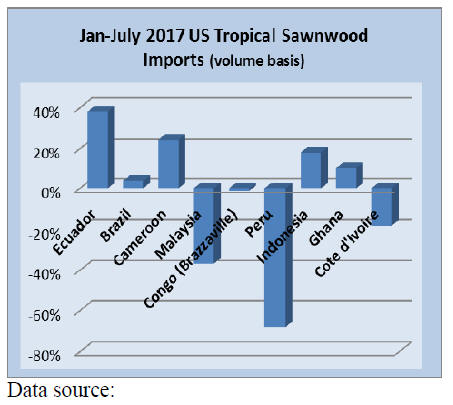|
Report from
North America
Lower sapelli imports from Cameroon and Congo
The volume of tropical sawnwood imports fell 16% in
July, but the value of imports was unchanged from the
previous month due to increased imports of higher value
species. 18,821 cu.m. of tropical sawnwood were imported
in July, worth US$21.6 million. US imports of temperate
sawnwood declined in July.

A slowdown in sapelli imports accounted for much of the
July drop in tropical imports, affecting mainly shipments
from Cameroon and Congo (Brazzaville). Sapelli imports
fell 56% month-over-month to 2,076 cu.m. in July. Balsa,
acajou d¡¯Afrique and cedro imports were also down from
June. Malaysian exporters benefitted from higher keruing
imports in July, up 63% from June. Year-to-date keruing
imports remained below July 2016 levels.
Ipe imports were slightly up from June at 2,488 cu.m.
Imports of most other species also increased in July,
including imports of jatoba, mahogany, virola and teak.
Teak sawnwood imports, mainly from Myanmar and
India, grew from the previous month. Teak imports were a
relatively small volume in July (485 cu.m.) but high value
(US$2.48 million). Teak imports from Myanmar
accounted for 239 cu.m. in July or US$1.18 million.
Canadian tropical sawnwood imports fall except
mahogany
Canadian imports of tropical sawnwood declined for the
second consecutive month in July to USUS$1.38 million.
Year-to-date imports were slightly lower than in July
2016.
Like in the US market the main decline was in sapelli
imports. Imports of virola, imbuia and balsa (combined)
were also down from June. Imports of mahogany more
than doubled in July to USUS$110,119.
Compliance dates extended for new formaldehyde
emissions standards
The federal Environmental Protection Agency (EPA) is
extending the compliance dates for the formaldehyde
emission standards for composite wood products. The
wood products industry and trade associations had
expressed concerns about meeting the compliance dates
set out in EPA¡¯s rule from December 2016.
A prepublication version of the final rule on formaldehyde
emission standards was published online on September 1,
2017. According to this prepublication rule the following
compliance dates will be extended:
 Manufactured-by date for emission
standards, Manufactured-by date for emission
standards,
recordkeeping, and labeling provisions: by one
year to December 12, 2018
 Import certification provisions: by
more than one Import certification provisions: by
more than one
year to March 22, 2019
 Provisions applicable to producers
of laminated Provisions applicable to producers
of laminated
products: by more than three months to March
22, 2024
The ¡°manufactured-by date¡± of composite wood products
is the reference date for the compliance date for the
emission standards, recordkeeping, and labeling
provisions. Beginning December 12, 2018 all imported
panels and component parts or finished goods subject to
the rule must comply with the emissions standards.
Existing stock of non-certified panels imported into the
US and existing stock of component parts and finished
goods that contain non-certified panels manufactured
internationally may continue to be distributed in
commerce and assembled into products until that stock is
depleted, providing documentation is kept regarding the
date of manufacture or import.
Additionally, composite wood products may be certified
by California Air Resources Board Third Party Certifiers
until March 22, 2019, so long as all aspects of the EPA
final rule on formaldehyde emissions are complied with.
The EPA extended the compliance dates and the
transitional period for California Air Resources Board
Third Party Certifiers to add flexibility for organizations,
reduce compliance burdens, and prevent supply chain
disruptions.
The full compliance date extension rule is available on the
EPA website: https://www.epa.gov/formaldehyde/compliancedate-
extension-formaldehyde-emission-standards-compositewood-
products-0
Steady growth in demand for kitchen cabinets and
office furniture
Cabinet sales were 1.8% higher in July compared to the
same time last year, according to the latest Kitchen
Cabinet Manufacturers Association (KCMA)¡¯s monthly
Trend of Business Survey. Year-to-date cabinet sales
increased 3.7% compared to July 2016.
The strongest growth in year-to-date sales was in stock
cabinets (+4.2%), followed by semi-custom cabinets
(+3.9%). Custom cabinet sales were almost unchanged
from 2016. The survey participants represent
approximately 70% of the US kitchen and bath cabinets
market.
Demand for office and contract furniture is also strong,
according to a quarterly survey of commercial furniture
manufacturers and suppliers (MADA / OFI Trends by
Michael A. Dunlap & Associates). Sales and employment
were up in July. Raw material costs increased from April,
which caused concern to many companies, according to
the survey.
New wood treatment to replace methyl bromide
fumigation
A new wood treatment method has been developed by
researchers at Pennsylvania State University that could
replace methyl bromide fumigation of wood. The US,
along with other countries, restricts the use of methyl
bromide and is phasing it out because the gas depletes the
ozone layer.
The international timber trade and the use of wood
packing and pallets in shipping would be negatively
affected without a cost-effective wood treatment that
controls insects at all stages. The patent-pending heat
treatment developed at Pennsylvania State University uses
radio-frequency waves. The researchers have received
funding to bring the technology to market.
|